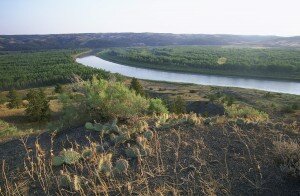As the U.S. Fish and Wildlife Service and partners draw up a new vision for the National Wildlife Refuge System for the next decade and beyond, it is also a good time to celebrate the past. National Wildlife Federation applauds the U.S. Fish and Wildlife Service for collaborating with partners on the Conserving the Future: Wildlife Refuges and the Next Generation vision document that will be presented for ratification at a conference in Madison, WI this July. We are eager to give input to the vision document in order to help the system solve the challenges of the 21st century and are proud to be intertwined with the early history and success of wildlife refuges.

Can you imagine Charles M. Russell National Wildlife Refuge in Montana without viable populations of elk, pronghorn, or sage grouse? (image: FWS)
National Wildlife Federation celebrates our 75th anniversary this year, and our first President, J.N. “Ding” Darling, was instrumental in the early history and success of the refuge system. Ding Darling was the Director of the U.S. Biological Survey, predecessor to the Fish and Wildlife Service, and he greatly increased refuge acreage, started the duck stamp program and even put his political cartoon skills into action when designing the Blue Goose logo.
The National Wildlife Refuge System is truly unique because it is the only federal system of lands and water that is specifically set aside “to conserve America’s fish, wildlife, and plants.” That is quite the responsibility given the current stressors to wildlife populations. Many factors have significantly reduced wildlife populations since President Theodore Roosevelt designated the first national wildlife refuge, Pelican Island, in 1903. But the greatest threat to wildlife today and in the future is global climate change.
Can you imagine Charles M. Russell National Wildlife Refuge in Montana without viable populations of elk, pronghorn, or sage grouse? Or much of Delta National Wildlife Refuge in Louisiana, gone due to sea level rise? These are the grim realities and challenges laid before us. Coastal and Alaskan refuges in particular are experiencing these effects—the crisis has already arrived.
The Fish and Wildlife Service should be commended in the way it has led in terms of being one of the first federal agencies to systematically grapple with climate change impacts. The challenge going forward is addressing the need for species to move in light of the growing pace of these impacts. FWS will need to team up with public and private partners to think creatively about how to manage the arrivals and departures of species in a way that maximizes benefits for wildlife and people. We shouldn’t just look at what we stand to lose from climate change and other stressors. We also need to envision the ecological role these lands and waters will play in the future, perhaps hosting different species than originally intended.
Over National Wildlife Federation’s 75 years, we’ve grown to love many different wildlife refuges, as they are home to many of the top wildlife watching spots in the country, and offer unparalleled recreational opportunities. We must recognize their value in order to continue this proud tradition of sustaining wildlife as well as provide direction and support in the midst of challenging conditions.
Continuing to develop a national strategy for adapting to the impacts of climate change to refuges should be one of the main goals of the vision that is adopted by those gathered in Madison, Wisconsin for the “vision conference” this summer. Our children and grandchildren will thank us. Please stand with us—we need your voice to combat the greatest challenge of this the 21st century.
Larry Schweiger, President and CEO, National Wildlife Federation



1 Comment in this post »
RSS feed for comments on this post. | TrackBack URL
Apparently the goal is to buy up all the land and create little islands to preserve only the species contained within the refuge boundaries. There are not enough staff in the Refuge system to adequately manage the lands already in the system, and now there is a request to increase the budget by $146M at the expense of other programs. Refuges only focus on birds and water to support birds with little interest in aquatic environments or fisheries. Current leadership of the agency is happy to gut other programs so we may as well change the name to the US Bird Refuge Service because clearly nothing else matters. If the land acquisition increase were reduced by $6M, other programs would remain whole and could continue to provide jobs and economic stability to communities where jobs are scarce but dependent upon the aquatic resources we try desperately to manage and protect. I guess we’ll all just work for the refuge system and close up the other programs within the service.